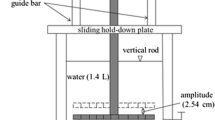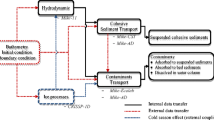Abstract
Purpose
In an aquatic environment, hydrodynamic condition is a ubiquitous natural process, and the contaminated sediments will act as a potential pollution source once they are remobilized into the overlying water. In this study, remobilization behavior of polycyclic aromatic hydrocarbons (PAHs) under simulated hydrodynamic conditions was studied. Additionally, an adjusted prediction model with addictive consideration of surface properties was developed to exhibit the distribution of PAHs in hydrodynamic system.
Materials and methods
An improved syntonic turbulence-simulation device (TSD) was used to simulate hydrodynamic conditions. Two sediments from the Yellow River Delta (YRD) and the intersection of Yangtze and Hanjiang River (YHR), respectively, were used to represent variations in organic carbon contents and sediment surface characteristics. Five PAHs including acenaphthene (Ace), fluorine (Flu), phenanthrene (Phe), fluoranthene (Fla), and pyrene (Pyr) were selected as the target compounds in this study.
Results and discussion
∑PAH concentrations in particles on volume normalization increased 74.1% and 18.5% for the YRD and YHR samples, respectively, and the same increasing trend was observed for individual PAHs. On mass weight basis, ∑PAHs were observed to decrease for both the YRD (from 2,039.5 to 1,149.7 ng g−1) and YHR (4,222.7 ng g−1 to 2,914.2 ng g−1) samples. Interestingly, concerning the different heights of the TSD, the YRD-associated PAHs showed an opposite behavior comparing with the YHR-bound PAHs.
Conclusions
The remobilization of less contaminated, larger-size particles was found to skew the PAH concentration downward, which resulted in the opposite PAH behaviors of the YRD and YHR samples. The distribution of PAHs between solid and liquid phases was affected by both organic carbon contents and surface areas of the remobilized sediments.





Similar content being viewed by others
References
Ahrens MJ, Depree CV (2004) Inhomogeneous distribution of polycyclic aromatic hydrocarbons in different size and density fractions of contaminated sediment from Auckland Harbour, New Zealand: an opportunity for mitigation. Mar Pollut Bull 48:341–350
Alkhatib E, Castor K (2000) Parameters influencing sediments resuspension and the link to sorption of inorganic compounds. Environ Monit Assess 65:531–546
Alkhatib E, Weigand C (2002) Parameters affecting partitioning of 6 PCB congeners in natural sediments. Environ Monit Assess 78:1–17
Allen-King RM, Grathwohl P, Ball WP (2002) New modeling paradigms for the sorption of hydrophobic organic chemicals to heterogeneous carbonaceous matter in soils, sediments, and rocks. Adv Water Resour 25:985–1016
Chen JW, Peijnenburg W, Quan X, Chen S, Martens D, Schramm K-W, Kettrup A (2001) Is it possible to develop a QSPR model for direct photolysis half-lives of PAHs under irradiation of sunlight? Environ Pollut 114:137–143
Chiou CT, McGroddy SE, Kile DE (1998) Partition characteristics of polycyclic aromatic hydrocarbons on soils and sediments. Environ Sci Technol 32:264–269
Colombo JC, Cappelletti N, Lasci J, Migoya MC, Speranza E, Skorupka CN (2006) Sources, vertical fluxes, and equivalent toxicity of aromatic hydrocarbons in coastal sediments of the Rio de la Plata Estuary, Argentina. Environ Sci Technol 40:734–740
DePinto J, Lick W, Paul J (1994) Transport and transformation of contaminants near the sediment-water interface. CRC Press/Lewis Publishers, Boca Raton, 33431
de Vicente I, Cruz-Pizarro L, Rueda FJ (2010) Sediment resuspension in two adjacent shallow coastal lakes: controlling factors and consequences on phosphate dynamics. Aquat Sci 72:21–31
Feng CL, Xia XH, Shen ZY, Zhou Z (2007a) Distribution and sources of polycyclic aromatic hydrocarbons in Wuhan section of the Yangtze River, China. Environ Monit Assess 133:447–458
Feng JL, Yang ZF, Niu JF, Shen ZY (2007b) Remobilization of polycyclic aromatic hydrocarbons during the resuspension of Yangtze River sediments using a particle entrainment simulator. Environ Pollut 149:193–200
Hedman JE, Tocca JS, Gunnarsson JS (2009) Remobilization of polychlorinated biphenyl from baltic sea sediment: comparing the roles of bioturbation and physical resuspension. Environ Toxicol Chem 28:2241–2249
Joo JC, Shackelford CD, Reardon KF (2008) Sorption of nonpolar neutral organic compounds to humic acid-coated sands: contributions of organic and mineral components. Chemosphere 70:1290–1297
Karickhoff S, Brown D, Scott T (1979) Sorption of hydrophobic pollutants on natural sediments. Water Res 13:241–248
Kim HS, Weber WJ (2005) Optimizing contaminant desorption and bioavailability in dense slurry systems. 2. PAH bioavailability and rates of degradation. Environ Sci Technol 39:2274–2279
Latimer JS, Davis WR, Keith DJ (1999) Mobilization of PAHS and PCBs from in-place contaminated marine resuspension events. Estuar Coast Shelf Sci 49:577–595
Lee BC, Shimizu Y, Matsuda T, Matsui S (2005) Characterization of polycyclic aromatic hydrocarbons (PAHs) in different size fractions in deposited road particles (DRPs) from Lake Biwa area, Japan. Environ Sci Technol 39:7402–7409
Long XX, Niu JF (2007) Estimation of gas-phase reaction rate constants of alkylnaphthalenes with chlorine, hydroxyl and nitrate radicals. Chemosphere 67:2028–2034
Martino M, Turner A, Nimmo A, Millward GE (2002) Resuspension, reactivity and recycling of trace metals in the Mersey Estuary, UK. Mar Chem 77:171–186
Niu JF, Yu G (2004) Molecular structural characteristics governing on biocatalytic oxidation of PAHs with hemoglobin. Environ Toxicol Pharmacol 18:39–45
Niu JF, Chen JW, Martens D, Quan X, Yang FL, Kettrup A, Schramm K-W (2003) Photolysis of polycyclic aromatic hydrocarbons adsorbed on spruce (Picea abies (L.) Karst.) needles under sunlight irradiation. Environ Pollut 123:39–45
Niu JF, Chen JW, Martens D, Henkelmann B, Quan X, Yang FL, Seidlitz HK, Schramm K-W (2004) The role of UV-B on the degradation of PCDD/Fs and PAHs sorbed on surfaces of spruce (Picea abies (L.) Karst.) needles. Sci Total Environ 322:231–241
Niu JF, Sun P, Schramm K-W (2007) Photolysis of polycyclic aromatic hydrocarbons associated with fly ash particles under simulated sunlight irradiation. J Photochem Photobiol A: Chem 186:93–98
Pignatello JJ, Lu YF, LeBoeuf EJ, Huang WL, Song JZ, Xing BS (2006) Nonlinear and competitive sorption of apolar compounds in black carbon-free natural organic materials. J Environ Qual 35:1049–1059
Rockne KJ, Shor LM, Young LY, Taghon GL, Kosson DS (2002) Distributed sequestration and release of PAHs in weathered sediment: the role of sediment structure and organic carbon properties. Environ Sci Technol 36:2636–2644
Saulnier I, Mucci A (2000) Trace metal remobilization following the resuspension of estuarine sediments: Saguenay Fjord, Canada. Appl Geochem 15:191–210
Smit MPJ, Grotenhuis T, Bruning H, Rulkens WH (2010) Modeling desorption kinetics of a persistent organic pollutant from field aged sediment using a bi-disperse particle size distribution. J Soils Sediments 10:119–126
Stout SA, Uhler AD, Emsbo-Mattingly SD (2004) Comparative evaluation of background anthropogenic hydrocarbons in surficial sediments from nine urban waterways. Environ Sci Technol 38:2987–2994
Tao S, Cao HY, Liu WX, Li BG, Cao J, Xu FL, Wang XJ, Coveney RM, Shen WR, Qin BP, Sun R (2003) Fate modeling of phenanthrene with regional variation in Tianjin, China. Environ Sci Technol 37:2453–2459
Tolosa I, de Mora S, Sheikholeslami MR, Villeneuve JP, Bartocci J, Cattini C (2004) Aliphatic and aromatic hydrocarbons in coastal Caspian Sea sediments. Mar Pollut Bull 48:44–60
Troisi GM, Borjesson L (2005) Development of an immunoassay for the determination of polyaromatic hydrocarbons in plasma samples from oiled seabirds. Environ Sci Technol 39:3748–3755
Urban SR, Correa AXR, Schettini CAF, Schwingel PR, Sperb RM, Radetski CM (2010) Physicochemical and ecotoxicological evaluation of estuarine water quality during a dredging operation. J Soils Sediments 10:65–76
van der Heijden SA, Jonker MTO (2009) Evaluation of liposome-water partitioning for predicting bioaccumulation potential of hydrophobic organic chemicals. Environ Sci Technol 43:8854–8859
Wang XC, Zhang YX, Chen RF (2001) Distribution and partitioning of polycyclic aromatic hydrocarbons (PAHs) in different size fractions in sediments from Boston Harbor, United States. Mar Pollut Bull 42:1139–1149
Wang Z, Chen JW, Yang P, Qiao XL, Tian F (2007) Polycyclic aromatic hydrocarbons in Dalian soils: distribution and toxicity assessment. J Environ Monit 9:199–204
Wang LL, Niu JF, Yang ZF, Shen ZY, Wang JY (2008) Effects of carbonate and organic matter on sorption and desorption behavior of polycyclic aromatic hydrocarbons in the sediments from Yangtze River. J Hazard Mater 154:811–817
Wang LL, Shen ZY, Wang HY, Niu JF, Lian GX, Yang ZF (2009a) Distribution characteristics of phenanthrene in the water, suspended particles and sediments from Yangtze River under hydrodynamic conditions. J Hazard Mater 165:441–446
Wang Y, Chen JW, Ge LK, Wang DG, Cai XY, Huang LP, Hao C (2009b) Experimental and theoretical studies on the photoinduced acute toxicity of a series of anthraquinone derivatives towards the water flea (Daphnia magna). Dyes Pigment 83:276–280
Wang Y, Chen JW, Li F, Qin H, Qiao XL, Hao C (2009c) Modeling photoinduced toxicity of PAHs based on DFT-calculated descriptors. Chemosphere 76:999–1005
Wang Z, Chen JW, Tian FL, Yang P, Qiao XL, Yao ZW (2010) Application of factor analysis with nonnegative constraints for source apportionment of soil polycyclic aromatic hydrocarbons (PAHs) in Liaoning, China. Environ Forensics 11:161–167
Xing BS, Pignatello JJ, Gigliotti B (1996) Competitive sorption between atrazine and other organic compounds in soils and model sorbents. Environ Sci Technol 30:2432–2440
Yang ZF, Feng JL, Niu JF, Shen ZY (2008) Release of polycyclic aromatic hydrocarbons from Yangtze River sediment cores during periods of simulated resuspension. Environ Pollut 155:366–374
Yang ZF, Wang LL, Niu JF, Wang JY, Shen ZY (2009) Pollution assessment and source identifications of polycyclic aromatic hydrocarbons in sediments of the Yellow River Delta, a newly born wetland in China. Environ Monit Assess 158:561–571
Acknowledgements
The research was supported by the National Basic Research Program of China (973 Program, 2006CB403303) and the National Science Foundation for Distinguished Young Scholars (50625926). We gratefully acknowledge project 40701166 supported by National Natural Science Foundation of China.
Author information
Authors and Affiliations
Corresponding author
Additional information
Responsible editor: Jan Schwarzbauer
Rights and permissions
About this article
Cite this article
Wang, L., Yang, Z. Simulation of polycyclic aromatic hydrocarbon remobilization in typical active regions of river system under hydrodynamic conditions. J Soils Sediments 10, 1380–1387 (2010). https://doi.org/10.1007/s11368-010-0286-3
Received:
Accepted:
Published:
Issue Date:
DOI: https://doi.org/10.1007/s11368-010-0286-3




